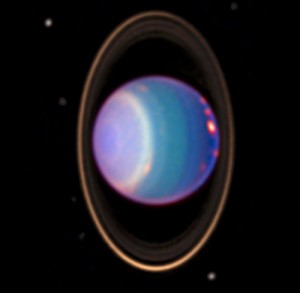Today’s post is brought to you by the Small Large Smelly Boy and his science report, which he read out loud at school today. Mr. and Mrs. Scatter have not changed a word.
*
 By Felix/Martha
By Felix/Martha
Did you know that the diameter of Uranus is four times that of the Earth’s? In fact, Uranus is so big that scientists have decided to name it after a Roman deity. According to legend, Uranus is the father of several titans, and it has much unkempt power – when Uranus’s power is let loose, disastrous things happen.
Uranus has a very strong gravitational pull, which means Uranus is very attractive. Many things are drawn to Uranus, including 27 moons orbiting around it, which were originally named after windy spirits, but now take the names of characters from Shakespeare’s plays. Scientists seem to think it important to associate Uranus with famous literary works.
Clouds of gas are emitted from Uranus, making it impossible for life to dwell there. Uranus is not hot. The average temperature there is -350°F, so ice usually clings to Uranus. Deep within Uranus is a core of solid metal.
Uranus is a sickly color of greenish blue, which is due to the fact that a layer of gases surround it, including methane, hydrogen and helium. Uranus has a lot of methane. Another example of Uranus’s gas is its rings, which are comprised of dust as well as gassy substances. There are eleven very faint rings around Uranus.
Uranus is smaller than Saturn and Jupiter but bigger than Neptune, the fourth largest planet. In 1791, William Herschel spotted Uranus through a telescope and did not know what it was. Nobody knew about Uranus then. His discovery of the gargantuan object made him famous.
Then, in 1986, 200 years after William Herschel’s discovery, the Voyager 2 landed on Uranus and took close-up pictures. These pictures helped people know that it takes Uranus 84.3 Earth years to move around the sun.
The tilt of Uranus’s axis is about 90°, which is unusual for planets. Scientists think a large object smashed into Uranus billions of years ago, which caused it to veer off its natural orbit.
*
Illustration: An image from the Hubble telescope in 1998 shows cloud bands, rings and moons around Uranus. Wikimedia Commons